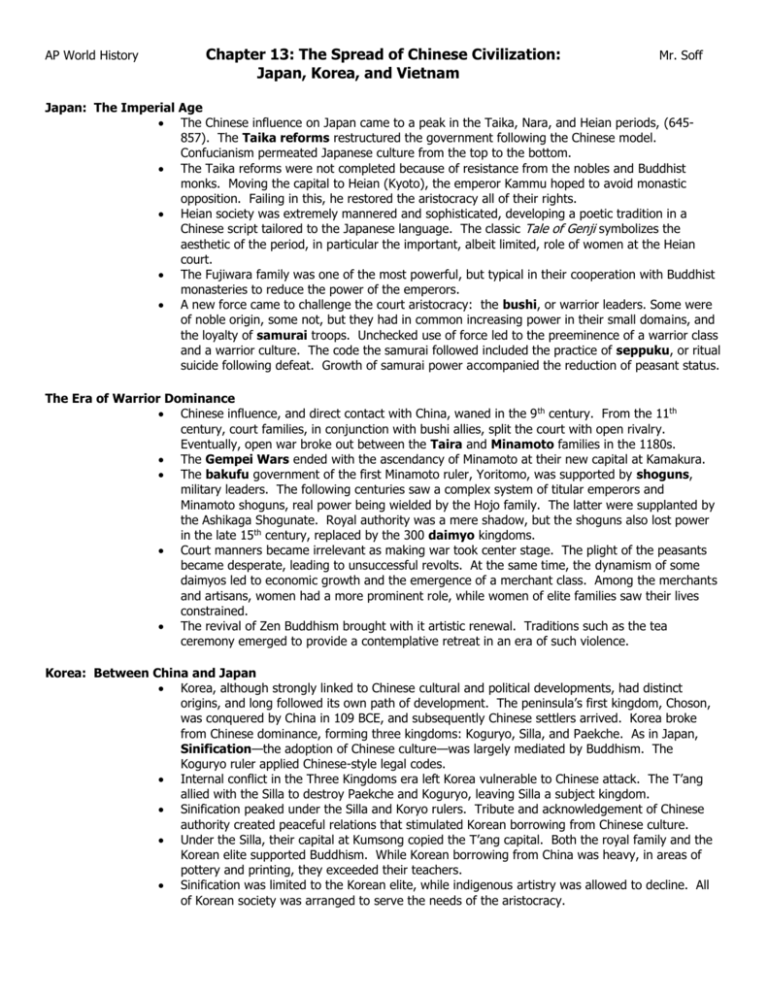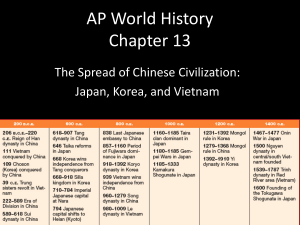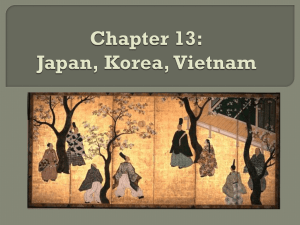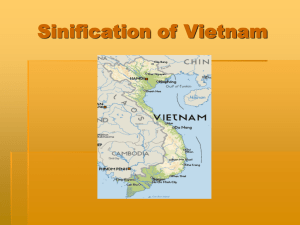AP World History Chapter 13: The Spread of Chinese Civilization: Mr
advertisement

AP World History Chapter 13: The Spread of Chinese Civilization: Japan, Korea, and Vietnam Mr. Soff Japan: The Imperial Age The Chinese influence on Japan came to a peak in the Taika, Nara, and Heian periods, (645857). The Taika reforms restructured the government following the Chinese model. Confucianism permeated Japanese culture from the top to the bottom. The Taika reforms were not completed because of resistance from the nobles and Buddhist monks. Moving the capital to Heian (Kyoto), the emperor Kammu hoped to avoid monastic opposition. Failing in this, he restored the aristocracy all of their rights. Heian society was extremely mannered and sophisticated, developing a poetic tradition in a Chinese script tailored to the Japanese language. The classic Tale of Genji symbolizes the aesthetic of the period, in particular the important, albeit limited, role of women at the Heian court. The Fujiwara family was one of the most powerful, but typical in their cooperation with Buddhist monasteries to reduce the power of the emperors. A new force came to challenge the court aristocracy: the bushi, or warrior leaders. Some were of noble origin, some not, but they had in common increasing power in their small domains, and the loyalty of samurai troops. Unchecked use of force led to the preeminence of a warrior class and a warrior culture. The code the samurai followed included the practice of seppuku, or ritual suicide following defeat. Growth of samurai power accompanied the reduction of peasant status. The Era of Warrior Dominance Chinese influence, and direct contact with China, waned in the 9 th century. From the 11th century, court families, in conjunction with bushi allies, split the court with open rivalry. Eventually, open war broke out between the Taira and Minamoto families in the 1180s. The Gempei Wars ended with the ascendancy of Minamoto at their new capital at Kamakura. The bakufu government of the first Minamoto ruler, Yoritomo, was supported by shoguns, military leaders. The following centuries saw a complex system of titular emperors and Minamoto shoguns, real power being wielded by the Hojo family. The latter were supplanted by the Ashikaga Shogunate. Royal authority was a mere shadow, but the shoguns also lost power in the late 15th century, replaced by the 300 daimyo kingdoms. Court manners became irrelevant as making war took center stage. The plight of the peasants became desperate, leading to unsuccessful revolts. At the same time, the dynamism of some daimyos led to economic growth and the emergence of a merchant class. Among the merchants and artisans, women had a more prominent role, while women of elite families saw their lives constrained. The revival of Zen Buddhism brought with it artistic renewal. Traditions such as the tea ceremony emerged to provide a contemplative retreat in an era of such violence. Korea: Between China and Japan Korea, although strongly linked to Chinese cultural and political developments, had distinct origins, and long followed its own path of development. The peninsula’s first kingdom, Choson, was conquered by China in 109 BCE, and subsequently Chinese settlers arrived. Korea broke from Chinese dominance, forming three kingdoms: Koguryo, Silla, and Paekche. As in Japan, Sinification—the adoption of Chinese culture—was largely mediated by Buddhism. The Koguryo ruler applied Chinese-style legal codes. Internal conflict in the Three Kingdoms era left Korea vulnerable to Chinese attack. The T’ang allied with the Silla to destroy Paekche and Koguryo, leaving Silla a subject kingdom. Sinification peaked under the Silla and Koryo rulers. Tribute and acknowledgement of Chinese authority created peaceful relations that stimulated Korean borrowing from Chinese culture. Under the Silla, their capital at Kumsong copied the T’ang capital. Both the royal family and the Korean elite supported Buddhism. While Korean borrowing from China was heavy, in areas of pottery and printing, they exceeded their teachers. Sinification was limited to the Korean elite, while indigenous artistry was allowed to decline. All of Korean society was arranged to serve the needs of the aristocracy. Periodic popular revolts were successful only in weakening the Silla and Koryo monarchies. The Mongol invasion in 1231 began a period of strife, ending with the founding of the Yi dynasty in 1392. Between China and Southeast Asia: The Making of Vietnam The early history of the Viet people is little known. Early Chinese raids into Vietnam in the 220’s BCE increased trade. Intermarriage with Mon-Khmer and Tai language groups furthered development of a distinct Vietnamese ethnicity. Many early traditions separated them from the Chinese, such as the nuclear family pattern and a greater role for women. The Han became dissatisfied with merely exacting tribute from the Viet rulers and began direct rule in 111 BCE. Sinification increased, and was used by the Viet rulers to consolidate their power over both their own peoples and those to the west and south. In spite of Chinese expectations, the Viets never became assimilated to Chinese culture. Indeed, a culture of anti-Chinese resistance developed. The rising of the Trung sisters in 39 CE underlined the continuing role of Vietnamese women. Continuing Chinese influence in Vietnam depended on overcoming physical barriers, and on the competence of Chinese rulers. Following the fall of the T’ang, the Vietnamese freed themselves completely by 939. Yet Chinese influence continued, particularly in the administration. An important exception was the scholar-gentry who never gained an important role in the Vietnamese regime. The lands of the Chams and Khmers attracted the Vietnamese. From the 11 th to the 18th centuries, the latter steadily expanded their territory at the expense of the Chams. Subsequently, they attacked the Khmers in the Mekong delta. The new southern territories were controlled only with difficulty by Hanoi. The Trinh family, ruling from the north, was challenged by the southern Nguyen family. The conflict left the Vietnamese oblivious to an outside threat: the French and the Catholic Church. Key Terminology: 1. Taika reforms: 2. Heian: 3. Tale of Genji: 4. Bushi: 5. Gumpei wars: 6. Bakufu: 7. Shoguns: 8. Daimyos: 9. Sinification: 10. Yi dynasty (1392–1910): 11. Trung sisters: 12. Khmers and Chams: Focus Questions: 1. What is the name of nature spirits in Japan? 2. Which religion played a key role in the transmission of Chinese civilization to Japan? 3. What were the reforms enacted in 646 that intended to thoroughly incorporate Chinese culture and political structure into Japanese society? 4. What was the central purpose of the reforms of 646 in Japan? 5. What seems to have been the primary concerns at the imperial Japanese court in Heian? 6. What was the military organization of the Heian government in Japan? 7. What was the impact of the rise of the samurai on the peasantry in Japan? 8. Describe the nature of warfare among the bushi. 9. The development of regional power bases in Japan among the warrior elites of the countryside corresponded to what events in China? 10. What was the relationship between the Ashikaga Shogunate and the emperor? 11. What was the political result of the wars that destroyed the Ashikaga Shogunate? 12. How did the principles of war change under the daimyos? 13. What was the status of women during the era of the daimyos? 14. During the period of the warring daimyos, what was the factor that led to a revival of Chinese influence on a cultural level? 15. What was China’s influence on Korea’s bureaucracy? 16. Describe the nature of Korean society. 17. What was the political result of the Vietnamese drive to conquer regions south of the Red River basin? 18. What cultural traits did the Chinese introduce to Vietnam after the Han conquest in 111 BCE? 19. Why wasn’t China able to assimilate the Vietnamese? 20. Following the assertion of Vietnamese independence from China in the 10th century, what aspects of Chinese culture were retained by Vietnamese rulers?







